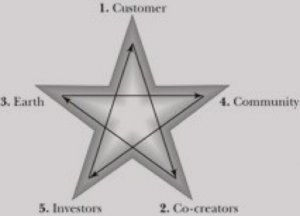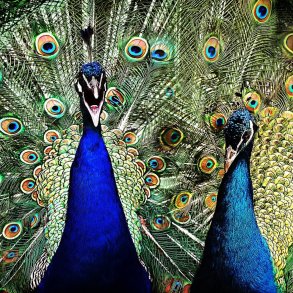By Eric Reynolds for Enlivening Edge
Teal, in the context of Frederic Laloux’s Reinventing Organizations, refers to organizational structures which encourage employees to bring their whole selves to work, fostering creativity and collaboration towards evolutionary purpose through hierarchies of actualization facilitated by self-organization. It is based upon wider literature in the field of developmental psychology, which states that individuals and societies mature throughout life, reaching increasingly complex ways of making meaning and organizing in social structures. Teal marks a cusp in development when the individual begins to become conscious of the constructed nature of one’s own reality, as well as the interdependent nature of life. It is profound and as yet relatively rare in individuals, let alone organizations. This marks the beginning of a whole new Reality.
Carol Sanford, author, educator and speaker has, been a leading change consultant to Fortune 500 companies for over 35 years and her books are required reading in leading business schools, including Harvard, Stanford, Haas Berkeley, and MIT. In her book The Responsible Business: Reimagining Sustainability and Success, Sanford distills her experience working with global businesses and new economy thought leaders in the areas of management, sustainability, and social responsibility encapsulated into the pentad below.
 The pentad represents the five major stakeholders of any organization, those being customers, co-creators, Earth, communities, and investors. The arrows represent the ongoing, reciprocal relationship between each of the stakeholders and the whole. “For a Responsible Business, the living entities — ecosystems, communities, and individuals — that it affects are not externalities; they are part of the body of the whole” (p. 28).
The pentad represents the five major stakeholders of any organization, those being customers, co-creators, Earth, communities, and investors. The arrows represent the ongoing, reciprocal relationship between each of the stakeholders and the whole. “For a Responsible Business, the living entities — ecosystems, communities, and individuals — that it affects are not externalities; they are part of the body of the whole” (p. 28).
The framework is not a prescription, it is a map to facilitate systems thinking. Think of the two-dimensional depiction as a placeholder of an interactive, holographic labyrinth, an active practice which a person and an organization walks daily, building awareness of itself and its parts. At the core it is quite simple; the implications far more profound. A business “simply” needs to consider its relationship with each of the five stakeholder categories in its decision making and its processes within the context of the company’s essence. “Understanding the uniqueness of a living entity is a critical prerequisite to working with its potential” (p. 162).
In order for this to take on an active reality, three capabilities must be developed at all levels of the organization: agency, ableness, and affectiveness.
“When I refer to self-determination, self-direction, and self-management, I am describing the practice of agency. When I talk about development of capacity or capability, I am describing ableness at higher and higher levels. When I advocate standing in the shoes of others, enriching their lives, or caring for the evolution of living systems, I am invoking the idea of affectiveness.” (p. 280).
In a way, the idea is that once people and organizations come to have an embodied understanding of living systems, and once they come to see themselves and their actions as part of a greater whole, then it simply becomes common sense to continue to develop one’s WHOLE self, individually and collectively. This becomes a practice of strengthening and healing the links that already exist between the webs of interactions that make modern life possible, while making new patterns along the way. “Living systems become both more complex and more essential through time. Ecological and biological systems not only adapt to their surroundings, they also transform them.”
Have you yet noticed that within this framework Laloux’s three breakthroughs are apparent: self-management, striving for wholeness, and listening to evolutionary purpose? Interestingly, when one truly takes a whole-systems perspective on business, these principles emerge. “Responsible Businesses foster nonhierarchical decisions, including those regarding sustainability and social responsibility, by making capability building a part of all educational and business endeavors” (p. 172). Not because it is the right thing to do, though arguments can be made, but because it is the ONLY thing to do.
And the “beauty” of it, besides the pride and warm-fuzziness of doing things right, and the unbridled creativity and co-operation that is released, is the potential! An entire planetary economy must be (re)made — that is, once one recovers from the shock of the sobering reality that hierarchies of domination, ecological ruin, and abject poverty have created an enormous market for platforms that heal. “The essence of [responsibility] strategy is to make it an issue for your competitor—not for your own company—because you’ve already made [responsibility] an integral part of your business.”
So to bring this home, a Responsible Business would fall within the Teal framework as presented by Frederic Laloux. However, can the reverse statement be made? Is Teal Responsible, in the sense that Carol Sanford defines the word? Here’s the thing: implicitly, I would say “Yes.” Self-management, wholeness and evolutionary purpose, in the context transforming our physical and cultural ecosystems for the greater good, is a Responsible Business. Healthy Teal is Responsible Teal. And yet, without the explicit acknowledgment of the systemic relationship of beings and the commitment to fostering ableness throughout society, there is possibility to falter.
Reference:
Eric Reynolds received his MA in Transformative Leadership from the California Institute of Integral Studies and is currently researching the concept of Next Stage organizations for his PhD in Organizational Leadership and Transformation (OLT) at Saybrook University. He is a transdisciplinary scholar, deeply fond of all knowledge. As Editor of Integral Leadership Review, he passionately bridges the many silos of human knowing, being, doing, and relating. [email protected], LinkedIn, FaceBook




